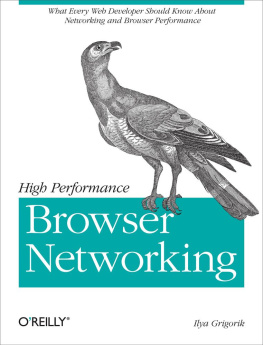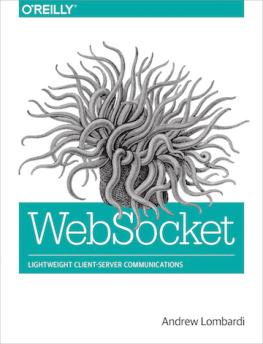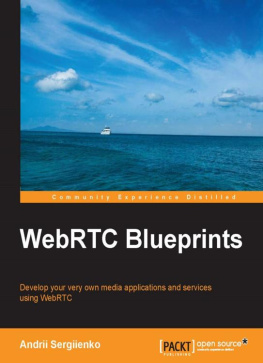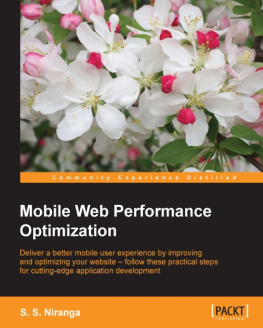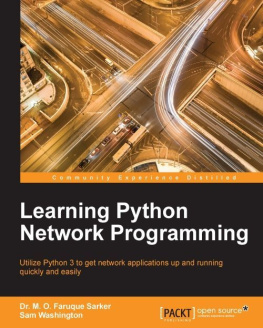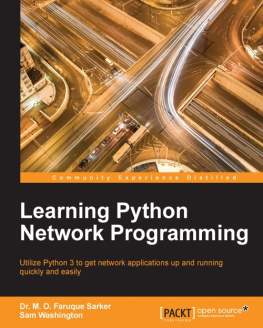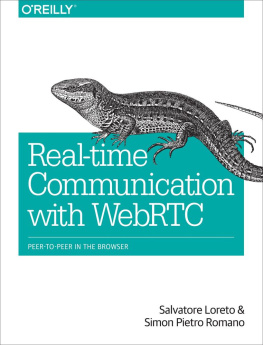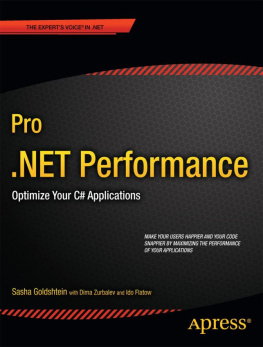High-Performance Browser Networking
Ilya Grigorik
Beijing Cambridge Farnham Kln Sebastopol Tokyo
Special Upgrade Offer
If you purchased this ebook directly from oreilly.com, you have the following benefits:
DRM-free ebooksuse your ebooks across devices without restrictions or limitations
Multiple formatsuse on your laptop, tablet, or phone
Lifetime access, with free updates
Dropbox syncingyour files, anywhere
If you purchased this ebook from another retailer, you can upgrade your ebook to take advantage of all these benefits for just $4.99. to access your ebook upgrade.
Please note that upgrade offers are not available from sample content.
Foreword
Steve Souders, Head Performance Engineer, Google, 2013
Good developers know how things work. Great developers know why things work.
We all resonate with this adage. We want to be that person who understands and can explain the underpinning of the systems we depend on. And yet, if youre a web developer, you might be moving in the opposite direction.
Web development is becoming more and more specialized. What kind of web developer are you? Frontend? Backend? Ops? Big data analytics? UI/UX? Storage? Video? Messaging? I would add Performance Engineer making that list of possible specializations even longer.
Its hard to balance studying the foundations of the technology stack with the need to keep up with the latest innovations. And yet, if we dont understand the foundation our knowledge is hollow, shallow. Knowing how to use the topmost layers of the technology stack isnt enough. When the complex problems need to be solved, when the inexplicable happens, the person who understands the foundation leads the way.
Thats why High Performance Browser Networking is an important book. If youre a web developer, the foundation of your technology stack is the Web and the myriad of networking protocols it rides on: TCP, TLS, UDP, HTTP, and many others. Each of these protocols has its own performance characteristics and optimizations, and to build high performance applications you need to understand why the network behaves the way it does.
Thank goodness youve found your way to this book. I wish I had this book when I started web programming. I was able to move forward by listening to people who understood the why of networking and read specifications to fill in the gaps. High Performance Browser Networking combines the expertise of a networking guru, Ilya Grigorik, with the necessary information from the many relevant specifications, all woven together in one place.
In High Performance Browser Networking , Ilya explains many whys of networking: Why latency is the performance bottleneck. Why TCP isnt always the best transport mechanism and UDP might be your better choice. Why reusing connections is a critical optimization. He then goes even further by providing specific actions for improving networking performance. Want to reduce latency? Terminate sessions at a server closer to the client. Want to increase connection reuse? Enable connection keep-alive. The combination of understanding what to do and why it matters turns this knowledge into action.
Ilya explains the foundation of networking and builds on that to introduce the latest advances in protocols and browsers. The benefits of HTTP 2.0 are explained. XHR is reviewed and its limitations motivate the introduction of Cross-Origin Resource Sharing. Server-Sent Events, WebSockets, and WebRTC are also covered, bringing us up to date on the latest in browser networking.
Viewing the foundation and latest advances in networking from the perspective of performance is what ties the book together. Performance is the context that helps us see the why of networking and translate that into how it affects our website and our users. It transforms abstract specifications into tools that we can wield to optimize our websites and create the best user experience possible. Thats important. Thats why you should read this book.
Preface
The web browser is the most widespread deployment platform available to developers today: it is installed on every smartphone, tablet, laptop, desktop, and every other form factor in between. In fact, current cumulative industry growth projections put us on track for 20 billion connected devices by 2020each with a browser, and at the very least, WiFi or a cellular connection. The type of platform, manufacturer of the device, or the version of the operating system do not mattereach and every device will have a web browser, which by itself is getting more feature rich each day.
The browser of yesterday looks nothing like what we now have access to, thanks to all the recent innovations: HTML and CSS form the presentation layer, JavaScript is the new assembly language of the Web, and new HTML5 APIs are continuing to improve and expose new platform capabilities for delivering engaging, high-performance applications. There is simply no other technology, or platform, that has ever had the reach or the distribution that is made available to us today when we develop for the browser. And where there is big opportunity, innovation always follows.
In fact, there is no better example of the rapid progress and innovation than the networking infrastructure within the browser. Historically, we have been restricted to simple HTTP request-response interactions, and today we have mechanisms for efficient streaming, bidirectional and real-time communication, ability to deliver custom application protocols, and even peer-to-peer videoconferencing and data delivery directly between the peersall with a few dozen lines of JavaScript.
The net result? Billions of connected devices, a swelling userbase for existing and new online services, and high demand for high-performance web applications. Speed is a feature, and in fact, for some applications it is the feature , and delivering a high-performance web application requires a solid foundation in how the browser and the network interact. That is the subject of this book.
About This Book
Our goal is to cover what every developer should know about the network: what protocols are being used and their inherent limitations, how to best optimize your applications for the underlying network, and what networking capabilities the browser offers and when to use them.
In the process, we will look at the internals of TCP, UDP, and TLS protocols, and how to optimize our applications and infrastructure for each one. Then well take a deep dive into how the wireless and mobile networks work under the hoodthis radio thing, its very differentand discuss its implications for how we design and architect our applications. Finally, we will dissect how the HTTP protocol works under the hood and investigate the many new and exciting networking capabilities in the browser:
- Upcoming HTTP 2.0 improvements
- New XHR features and capabilities
- Data streaming with Server-Sent Events
- Bidirectional communication with WebSocket
- Peer-to-peer video and audio communication with WebRTC
- Peer-to-peer data exchange with DataChannel
Understanding how the individual bits are delivered, and the properties of each transport and protocol in use are essential knowledge for delivering high-performance applications. After all, if our applications are blocked waiting on the network, then no amount of rendering, JavaScript, or any other form of optimization will help! Our goal is to eliminate this wait time by getting the best possible performance from the network.

